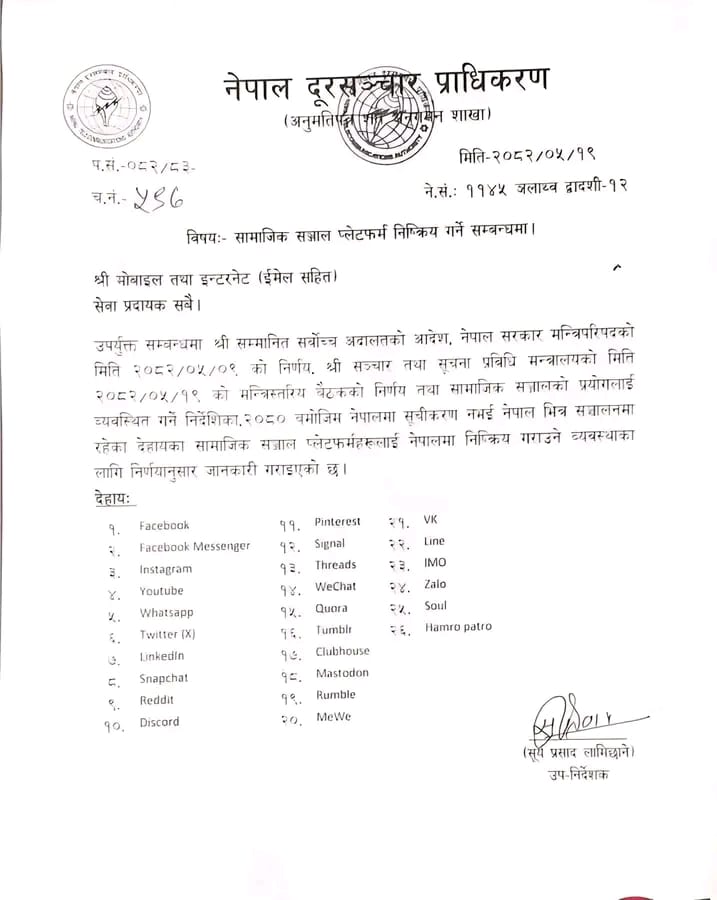During the ongoing ‘Gen Z’ protests in Nepal, violence has erupted, leading to the death of 19 people so far. Unable to control the growing unrest and rising opposition, Home Minister Ramesh Lekhak has resigned from his post
What is the meaning of Gen “Z”
The Nepal government had no issue with people using social media until it announced that all such platforms must be officially registered. However, many of these social media platforms were not registered, which is why the government decided to ban them.
“Gen Z” here refers to the situation where all platforms of social media and several daily life services were shut down by Nepal’s Home Minister and the government. Since social media and these digital tools are a part of people’s everyday life, the shutdown affected them heavily. As a result, citizens, especially the youth, started staging protests and sit-ins in front of the Parliament. This movement is being called the “Gen Z protests.”
-
- Messenger
- YouTube
- Twitter (X)
- Snapchat
- Discord
- Signal
- Threads
- Quora
- Tumblr
- Clubhouse
- Mastodon
- Rumble
- MeWe
- VK (VKontakte)
- Line
- IMO
- Zalo
- Soul
- Hamro Patro
Due to the shutdown of social media,
The Nepal government had no issue with people using social media until it announced that all such platforms must be officially registered. However, many of these social media platforms were not registered, which is why the government decided to ban them.

Social Media Platforms That Will Continue to Operate in
The Ministry confirmed that five social media platforms have successfully completed registration and will remain fully operational:
- TikTok
- Viber
- Nimbuzz
- WeTalk
- OpoLive
Why Did Nepal Ban Unregistered Social Media Platforms?
According to officials, this is a positive step taken following the order of Nepal’s Supreme Court, which instructed the government to regulate digital platforms with stricter oversight. The administration stated that registration would ensure accountability, data security, and proper monitoring of online activities.
The Ministry further clarified that the ban is not permanent. Once any platform completes the required registration process, it will be allowed to resume operations in Nepal.
In this protest, more than 20 lives have been lost and over 100 people have been injured.
In Nepal’s protests led by Gen Z youth, 16 people have lost their lives so far and more than 100 have been injured. If the situation continues like this, and if the government does not restore the communication and social media services that remain shut, more lives could be lost and many more people may get injured. Therefore, the services will only be resumed after completing the required registration process.
Nepal Protests Turn Deadly, Over 20 Killed, Home Minister Resigns
Nepal is witnessing one of its most intense waves of protests in recent years, largely driven by the country’s younger generation, often referred to as “Gen Z.” The demonstrations erupted after the government decided to ban several social media platforms and communication services that had not officially registered with the authorities.
What began as peaceful protests quickly turned violent, leading to tragic consequences. According to official reports, more than 20 people have lost their lives so far, while over 100 have been seriously injured. The unrest has spread across major cities, with thousands of young citizens gathering in front of the Parliament to demand the restoration of social media and digital platforms that are deeply embedded in their daily lives.
Facing increasing criticism and public pressure, Nepal’s Home Minister Ramesh Lekhak tendered his resignation, acknowledging the government’s inability to control the escalating situation. Officials argue that the ban is in line with a Supreme Court directive requiring stricter regulation of digital platforms to ensure accountability and data protection. They have also clarified that the ban is not permanent. Once platforms complete the mandatory registration process, they will be allowed to operate again in the country.
However, with anger and frustration still high among the youth, the protests show no signs of slowing down. Observers warn that if communication services are not restored soon, the death toll could rise further, and Nepal may plunge into deeper political instability